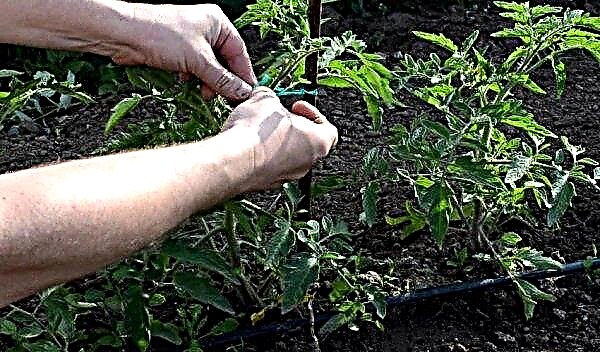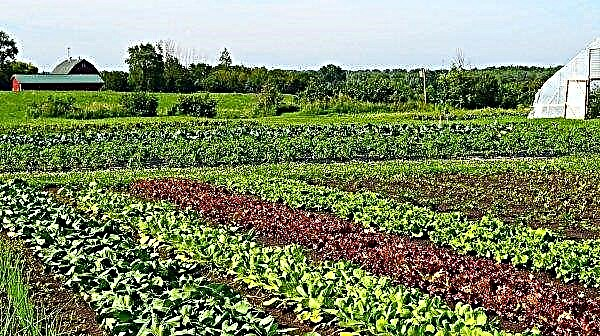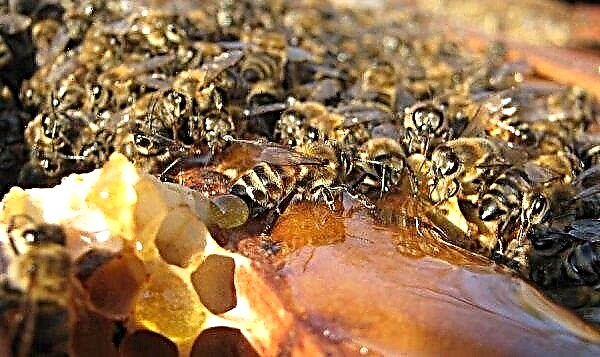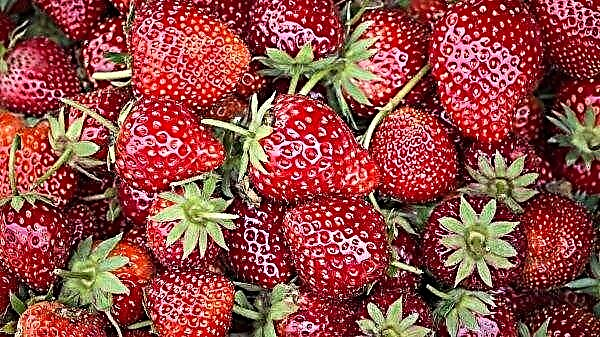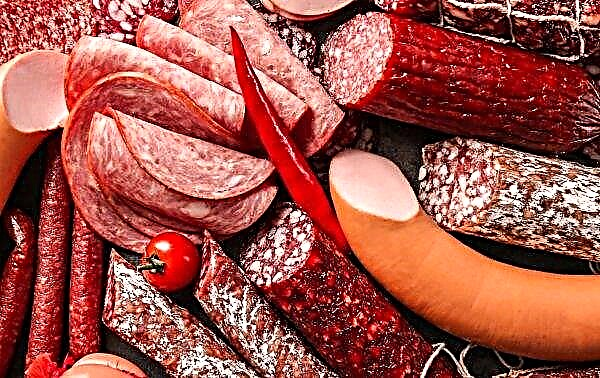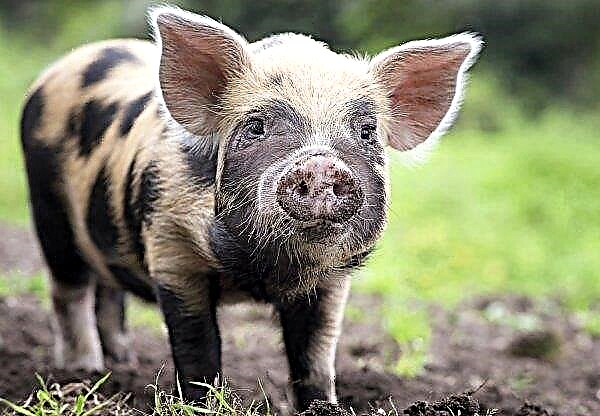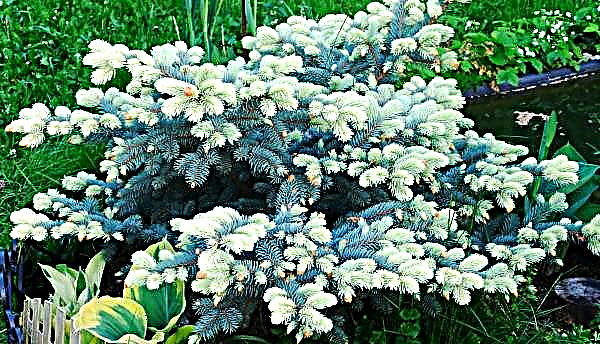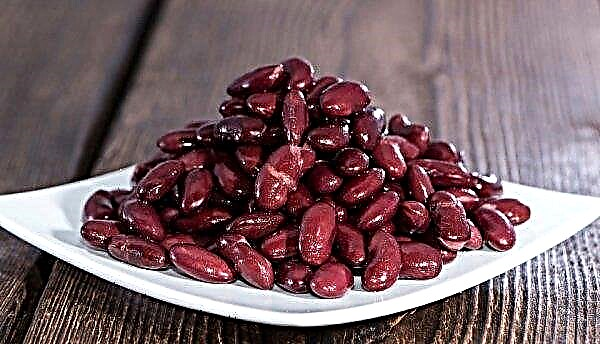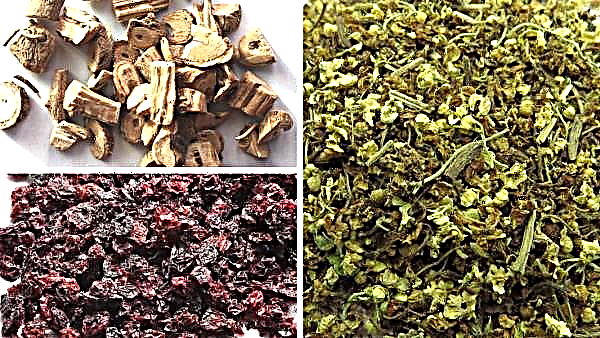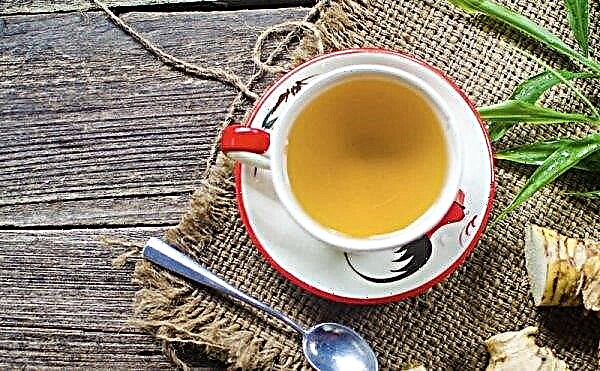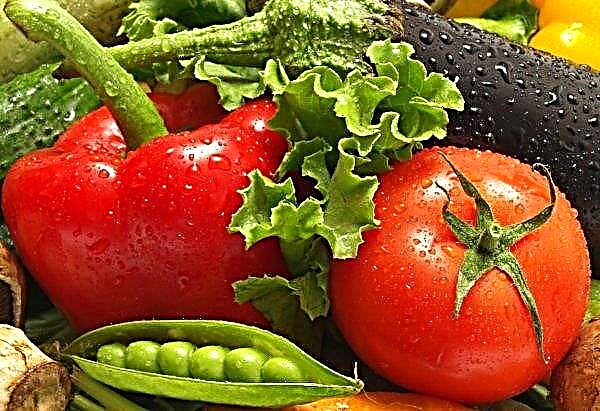The successful maintenance of chickens in the household depends largely on their proper nutrition. Most poultry farmers agree that it is better to feed the bird with compound feed. On the market you can buy its different types, as well as cook it yourself.
What is feed
The name itself quite readily explains what feed is. This is a combined diet consisting of various ingredients. They are mixed in certain proportions depending on the desired result and purpose.
In general, there are three types of feed:
- are used as the main diet or, in other words, full-time;
- introduced as a supplement when eating juicy and roughage - concentrates are used in animal husbandry;
- additives to create a balance in the diet - they include in different proportions protein, fodder yeast, minerals, vitamins, premixes, etc.

The effect of feed on the body of chickens
Chickens are happy to eat compound feed, if it is correctly selected. He is selected taking into account the age of the bird, its purpose. A scientific approach is applied to its creation, taking into account all the necessary factors for proper nutrition of the bird.
Benefit
- The benefits of a feed ration can be described as follows:
- food is balanced with the needs of birds;
- the bird feels healthy;
- essential minerals and vitamins are present in the feed;
- even a small amount of feed will saturate the bird;
- You can experiment with the composition, choosing the most acceptable;
- there is no need to feed pets with vegetables, grain, additives;
- the need to change the diet at different times of the year disappears;
- saving storage space.
Harm
- In some cases, feed can be harmful, namely:
- if the composition does not fit the bird;
- if it is of poor quality;
- if it contains harmful additives such as antibiotics, enzymes, dyes;
- if it contains too many vitamins and minerals, which can cause allergies;
- if storage conditions are not met.

The composition of different types of feed
A certain bird breed needs to be fed with compound feed specially made for it. So, for laying layers one composition is offered, and for broilers - another. Depending on the ingredients, there are various types of feed.
Carbohydrate
Even the name suggests that in these feeds the main emphasis is on the carbohydrate component. Carbohydrates contribute to weight gain and slow down metabolism. Carbohydrate fodder to a large extent contains fiber, starch, sugar.
Pets are quickly saturated with it and gain weight well, so it is considered optimal for meat breeds. There are four types of feed with a lot of carbohydrates.
Cereal feed
The essence of grain feed is the correct mixing of different types of grains. They can include cereals, corn, oats, barley.
You should only know what will benefit and in what quantities:
- The main component of cereal grains is starch. It accounts for 70% of the composition. Next up are protein, minerals and fats. The disadvantage of cereals is that they contain fiber, which is poorly absorbed, in addition, the protein has few amino acids.
- Corn grains lead in the amount of beneficial protein in the composition. Their plus is also a low fiber content and the presence of carotene, so they will be the most useful in the composition of the feed.
- The advantage of oats is that it is saturated with amino acids, and the minuses include a large amount of fiber in it. Because of the latter, it is slowly digested, which can adversely affect the health of young animals. It is advised to add oats or flour from it to feed at a level of no more than 20%. It is also advisable to peel the grains, germinate.
- Feed wheat is good in compound feeds due to its high content of vitamins E and group B. Protein in it is less than in normal, its content in the diet should not exceed 30%.
 You can add a little barley to the feed, but rye and buckwheat are not recommended.
You can add a little barley to the feed, but rye and buckwheat are not recommended.Succulent feed
Juicy feeds are vegetables, namely: potatoes, beets, turnips, pumpkin, rutabaga. All vegetables contribute to better digestion of food. Beets and potatoes are especially good at doing this. Before feeding, it is desirable to grind them and heat them.
Pumpkin has a lot of sugar, carotene, and B vitamins. Birds love it very much. The main disadvantage of a vegetable diet is that it spoils very quickly. The remains of it must be immediately removed to prevent the process of decay.
Important! Before giving the chickens vegetables, they must be cleaned and washed. They should be without rot. Otherwise, infections cannot be avoided.
Cereal waste
Poultry farmers are reluctant to add grain waste to animal feed. As a rule, these are the residues from the processing of wheat grains. In addition to the presence of weed, fungus and ergot seeds in them, it can be noted that they are of no interest in nutritional value. They have too much fiber and harmful phosphorus.
Industrial waste
In the chicken diet, you can add waste after the production of alcohol or processing beets. The former are called bards and are potato, wheat, corn. They have sugar, vitamin B, fiber. You can add them to the feed about 7%.
Protein
Protein plays a very important role in the structure of a living cell, therefore its presence is so important in the diet of a bird. Its main source is fish, meat and bone meal, oilcake, bean grains, alfalfa flour. Protein-based feeds improve the quality of egg white and strengthen the shell.
Significantly increase the "performance" of laying hens. Such feeds also contribute to better digestion, strengthen the skeleton and muscle mass of pets. Recommended for egg and meat-egg breeds. By origin, they are divided into two types - animal and vegetable.
Animal content
Proteins of animal origin are marketed in the form of flour. Species are characterized by what it is made of.
Animal feed is more saturated with vitamins and minerals than vegetable:
- Fishmeal is made from fish industry waste, fish entrails and fish that are not used by humans. Its protein is very rich in amino acids and is perfectly absorbed by the avian organism. As a rule, such flour should be added to the diet no more than 8%, preferably in wet food.
- Flour from bones and meat is similar to cereals in the amount of protein. But its fat content is greater; it also consists of ash by 30%. Contains vitamins A, E, etc.
- Enough proteins and amino acids are in the blood meal. It is a product of the processing of blood and bones. More than 4% do not give it because of possible problems with the chicken’s stomach.
- Feathers are produced from bird feathers and down. It is quite cheap, but you can not say about the benefits. You can add to the chicken diet no more than 2%.
 All such feed should be made exclusively in accordance with GOST.
All such feed should be made exclusively in accordance with GOST.A protein diet can be varied by feeding feathered leftovers from dairy production, such as milk and its derivatives. If possible, this will be an excellent supplement to the protein diet of birds. There are a lot of vitamins, amino acids, sugar, and minerals in dairy products.
As protein feed, you can add up to 10 g of fresh earthworms. They can be grown independently in a compost pit.
Plant content
The bulk of vegetable protein in the chicken diet is in legumes and oilcake. Legumes are presented in mixed fodder soy and peas. The first is rich in vitamins, amino acids, minerals and in properties is not inferior to animal protein. Peas have a lot of protein and amino acids. It can be added up to 10%.
Adult chickens can include in the diet up to 17% of sunflower or soybean meal, meal. Young animals should be given no more than 10%.
Combined
It is possible to combine different types of combined feed, as well as add vitamins, minerals, yeast to them. The so-called hash is a variant of the combined type of diet. In it, in the right proportions, grain, flour, vitamins, water are mixed. This mixture is most often given to young animals. Its humidity should be at least 40%. Instead of water, you can add broth, whey.
This mixture is most often given to young animals. Its humidity should be at least 40%. Instead of water, you can add broth, whey.
Standards and quality requirements
In order to choose high-quality compound feed, you need to pay attention to the following norms and requirements:
- the food should be pleasant in smell: it should not smell like mold, rot, musty;
- the percentage of moisture for bird feed should not exceed 13%;
- grinding of feed should correspond to the category of bird for which it is intended (the chicken will not be able to eat large grains);
- compound feed should not contain harmful impurities;
- the presence of sand in the feed is unacceptable;
- feed for young animals should not contain a lot of fiber;
- for each category of poultry there should be an optimal amount of vitamins and minerals;
- feed must meet veterinary standards.
Important! If, after entering the feed, you notice any abnormalities in the behavior or well-being of the pets, stop giving the feed and ask your veterinarian for advice. The feed may not be suitable or balanced.
Features of the choice and preparation of feed
In order to choose the right feed, you need to build on what breed the chicken in your farm belongs to. Different breeds need different species or in different proportions. The age of the birds must also be taken into account. So, young food is not suitable for adult chickens. If you choose ready-made feed, then you need to pay attention to the manufacturer. High-quality feed can be produced only on good equipment. A trusted manufacturer has fairly high quality standards.
If you choose ready-made feed, then you need to pay attention to the manufacturer. High-quality feed can be produced only on good equipment. A trusted manufacturer has fairly high quality standards.
The composition of the feed should be vitamins, minerals and other useful additives. Do not buy food with enzymes, antioxidants, antibiotics, dyes.
As for the manufacture of compound feed yourself, you need to know how to cook it, and purchase the necessary high-quality ingredients. Cereals, legumes should have a good appearance, not to smell of mold and dampness. Vitamin supplements, flour must meet quality standards.
It is better to buy such ingredients in a store rather than in the market. In the latter case, there is a chance of their infection.
One cannot say unequivocally which feed is better: purchased or home. The first is scientifically developed taking into account the needs of birds of any age and breed. It has already been prepared, it is enough to just pour it on - there is no need to waste time buying and mixing the components.
And for the price it will be cheaper. However, there is a possibility that your pets may not like it, and there are also risks of poor quality and the presence of harmful ingredients. In the case of home-made compound feed, it can be made exclusively suitable for your birds according to their taste preferences. You will be sure of the quality of the ingredients used.
In the case of home-made compound feed, it can be made exclusively suitable for your birds according to their taste preferences. You will be sure of the quality of the ingredients used.
Did you know? A chicken can remember about a hundred objects, while she knows her master and can recognize him from afar.
DIY compound feed recipe
It will not be difficult to make home-made compound feed. Here is a recipe from an experienced house.
Composition and proportions
You need to take 2 buckets of wheat and oats and half a bucket of sunflower seeds. In kilograms, this will be 16 and almost 4, respectively.
DIY feed for laying hens: video
Step-by-step cooking instructions
The process of preparing feed is as follows:
- Pour all the ingredients in one container and mix thoroughly.
- Turn on the grinder.
- Pour the right amount of mixture into it and grind it.
- Steam the crushed mixture with water and allow to cool.
- In the cooled mass add meat, bone and fish flour (3-5%).
- Add premix and feed sulfur.
Food can also yeast.
To process 10 kg of feed, do the following:
- In 1 liter of water with a temperature of up to +40 ° С, dilute 100 g of ordinary baker's yeast.
- Stir, eliminating lumps, until bubbles form.
- For greater effect, you can add 0.5 kg of beets, barley or 100 g of sour milk.
- In 15 liters of warm water add the finished mixture, mix again.
- Infuse for 5 to 9 hours, constantly stirring.
Important! Water in birds should be in large quantities if you feed them with combined feeds. If it is absent or few, digestive system disorders are possible.
Yeast contains vitamins A, E, B, D, iron, phosphorus. You can purchase special chicken vitamins for supplementation in feed. They should also contain calcium, iron, phosphorus, vitamins of the main groups.
The best purchased feed
The market is filled with a variety of chicken feeds from various companies. Poultry farmers have a unique rating of trusted producers whose feed is trustworthy. Feel free to buy feed brands "Gatchina", "Istra", as well as those that produce Ramensky and Kursk combines of bakery products.
- The Gatchina feed mill is equipped with modern equipment and produces almost all types of feed for chickens, rabbits, pigs, horses, fish.
- "Istra-bakery product" is more focused on the production of chicken feed. They make up the lion's share of its production. The company produces granular and loose feed.
- Ramensky bakery is a large enterprise with the latest computer software. It processes more than 500 tons of grain per day. The plant produces an extensive line of compound feeds for poultry, cattle, pigs, rabbits, dogs.
- Kursk bakery specializes in the manufacture of all feed for farm animals and birds. Feed packaging is possible from 10 to 40 kg. He is the only one of all of the above who produces rare PK-0 chicken feed.
Further, we will dwell in more detail on the composition of some compound feeds and on which birds they are intended for.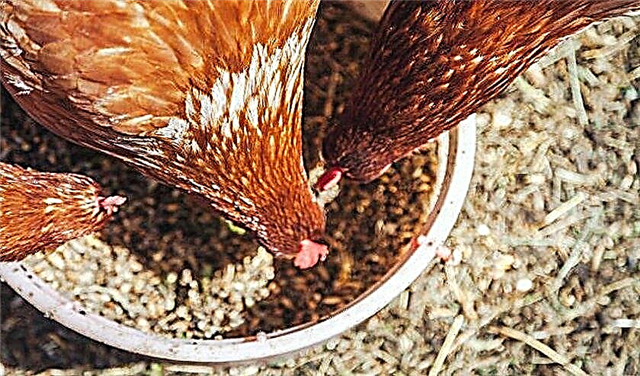
Pc-0
The food is aimed at chickens, mainly broilers, from the moment of birth to two weeks. It is considered quite rare, but very popular.
Compound feed consists of:
- wheat and corn;
- meal of sunflower and soybeans;
- fish and limestone flour;
- vegetable oil, salt;
- premix of vitamins and minerals;
- enzymes, antioxidants, betaine hydrochloride.
This compound feed is a starter, well fortified and mineralized, contains beneficial bacteria and a complex for the prevention of coccidiosis. 100 g of product contains 300 kcal. Represents small granules.
PK-1
Designed for laying hens after a year. Less calories, unlike PC-0, 16% of it falls on crude protein. Highly nutritious, contains a balanced vitamin-mineral complex.
The main ingredients are:
- corn and wheat;
- soybean mackerel;
- sunflower in the form of meal;
- limestone flour, salt;
- supplements from minerals, vitamins.

PC-2
This diet can be used for chickens after PK-0 until the age of two months. The composition is well balanced for easy absorption by young animals. In addition to vitamins and minerals, it contains funds for the prevention of diseases. 100 g contains 290 kcal.
The composition of the mixture includes:
- corn and wheat;
- meat and fish meal;
- meal and sunflower oil;
- chalk and salt;
- premix, L-lysine monochlorohydrate and methionine.

PC-3
You can immediately switch to this diet after the PK-2 compound feed and give young animals up to four and a half months. It is crushed so that it is easier for young birds to eat it.In addition to the main components, it contains probiotics to improve the digestive tract.
Crude protein is 16% by weight with a calorie content of 260 kcal per 100 g.
Consists of:
- wheat and corn;
- soybean flakes;
- meal of sunflower;
- limestone flour, salt;
- supplements from vitamins and minerals.
Did you know? Chickens can be taught to count and distinguish geometric shapes.
Mixed feed
Having prepared or bought ready-made compound feed, you will provide your birds with a balanced diet. Each bird breed should have its own feeding diet, you need to understand how to properly assemble and give it. So, laying hens need more protein, and meat breeds need more carbohydrates. In a home-made feed, you need to add a vitamin-mineral complex. If you buy ready-made feed, then the need for this action disappears. In addition, as practice shows, the consumption of purchased feed is much lower than homemade. There is a daily norm of feed consumption per day for chickens of different ages.
Young animals
For small chickens, the first 1–7 weeks of life is especially important. They need to be fed properly and balanced. If you feed young animals with home-made compound feed, then you need to start eating with food based on chopped corn grits.
Babies up to two weeks need about 40 g of food per day. With age, the norms increase about twice every two weeks. However, you need to monitor the state of health of young animals and not overfeed it much.
When feeding homemade feed, vitamins A, E, B and minerals must be added to it. As the latter, crushed eggshells can be successfully used. You can feed young animals with the combined feed from the first days of life.
It contains the whole complex of substances necessary for a young chicken body. You need to start with 10 g per day, by eight weeks, gradually increasing the dose to 50 g. The dosage is described in more detail on the package with food. To the question: is it necessary to give additional vitamins in this case, the poultry farmers give a negative answer, since this can provoke a digestive disorder and an allergic reaction.
As for the question: which food is better to give - dry or steamed - there is no unequivocal opinion regarding home-made food. Some poultry farmers say they need to be steamed, others say no. Young animals can try to steam home feed for its better digestibility.
But it’s worth remembering that it must be removed to prevent the spread of infections. Manufacturers steaming purchased food not only do not advise, but even prohibit it. Boiling water kills nutrients, and the consistency of the feed becomes not very suitable for consumption.
Adults
An adult bird needs about 120 g of feed per day. Rates may vary depending on the diet. With the predominance of protein and juicy carbon nutrition in it, the dose can be increased to 180 g.
Chickens who eat commercially available feed, it is quite possible to feed one type of feed. The same should be adhered to when feeding a bird with home-made combined food. It is only important to find the proportions that suit your pet.
Poultry farmers say some chicken breeds are reluctant to switch to a different diet. In any case, the translation should be done gradually.
In exceptional cases, you can give poultry a combined feed or mixed feed for rabbits. The first is more universal in composition, but contains a lot of salt, which is undesirable for birds. In the rabbit, as a rule, there is a lot of salt and protein, so it is better to limit its intake as much as possible.
In addition, you need to study the composition of such feeds and calculate the dosage for chicken according to the norm of grain, protein, vitamins.
Feeding chickens with compound feed is today considered the best way to eat. With this food, the hen receives all the substances necessary for the body. It is enough to decide on the choice of feed. It can be prepared both with your own hands and purchased already prepared.

